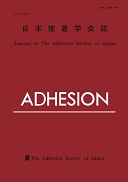All issues

Volume 42, Issue 3
Displaying 1-5 of 5 articles from this issue
- |<
- <
- 1
- >
- >|
Review
-
Kei KAMINO2006 Volume 42 Issue 3 Pages 117-121
Published: March 01, 2006
Released on J-STAGE: October 31, 2015
JOURNAL FREE ACCESSDownload PDF (2131K)
Review
-
Reiko SAYTOU, Toshihisa SHIMO2006 Volume 42 Issue 3 Pages 112-116
Published: March 01, 2006
Released on J-STAGE: October 31, 2015
JOURNAL FREE ACCESSDownload PDF (1710K)
Technical Report
-
Toshimichi MATSUZAKA, Eiji YOSHIDA, Hiroaki NAKAMURA, Tetsuji IWASAKI2006 Volume 42 Issue 3 Pages 106-111
Published: March 01, 2006
Released on J-STAGE: December 31, 2014
JOURNAL FREE ACCESSSurgical tape used in the medical applications generally has been contained organic solvents and monomers residue in the adhesive. Most amounts of the organic solvents have been removed from adhesive by modified the production process.However, non-reactive monomers could not removed from adhesive under conventional synthetic process. A lot of skin irritations which caused to nonreactive residue in adhesive have been reported in medical application. Therefore, we have focused on aqueous emulsion adhesive without containing organic solvent and without occuring monomer residue in adhesive.However, one of the weak point of emulsion adhesive is easily peel out by insensible water loss. Therefore, to obtain the high performances against water resistance property, we have investigated particle diameter of micelle as well as various species of monomer incorporated inadhesive.As a result, we have developed new emulsion adhesive, which have high performance regarding peel strength by using methyl acrylate monomer under sauna condition.View full abstractDownload PDF (2280K)
Original Paper
-
Toru IKEDA, Deok-bo LEE, Noriyuki MIYAZAKI2006 Volume 42 Issue 3 Pages 97-105
Published: March 01, 2006
Released on J-STAGE: December 31, 2014
JOURNAL FREE ACCESSExamining the effect of bond thickness on the fracture toughness of adhesive joints is a common issue; however, the mechanism of this effect has not been elucidated. Damage zones around crack tips in adhesive joints with several bond thicknesses were observed using an optical microscope. Interfacial damage zones were observed in cases of bond thickness of less than 0.7mm. Specially, large interfacial damage zones grew in an adhesive layer of 0.3 mm bond thickness, which showed maximum fracture toughness. The stress shielding effect of the interfacial damage zone was expected to increase the fracture toughness of this adhesive joint. Analyses of damage around crack tips in adhesive joints were performed using the finite element method (FEM) inconjunction with Gurson's model. The result of the FEM analyses showed the increase of stress and damage in cases of thinner adhesive layers, which means a monotonic decrease of fracture toughness accompanied decreased bond thickness. Then, artificial damage along the interface between an adhesive layer and adherends was introduced in the FEM analyses. These analyses showed the maximum fracture toughness of an adhesive joint with a bond layer of about 0.3 mm, and the results confirmed the stress shielding effect of the interfacial damage zoneView full abstractDownload PDF (3198K)
Original Paper
-
Satoru IWAMORI, Akihiro UEMURA2006 Volume 42 Issue 3 Pages 89-96
Published: March 01, 2006
Released on J-STAGE: December 31, 2014
JOURNAL FREE ACCESSPolymer thin films were sputtered onto copper substrate with a polyimide target. Argon and nitrogen were introduced into the sputtering chamber for the sputtering gases. Although sputtering rate of the polymer thin film with argon gas showed highest value at a pressure of 5mTorr. On the contrary, the sputtering rate of the polymer thin film with nitrogen gas showed highest value at a pressure of 60mTorr. Nitrogen content in the thin film sputtered with the nitrogen gas (N2 sputtered thin film) increased compared to that sputtered with argon gas (Ar sputtered thin film) and target material. Frictioncoefficient and abrasion durability of the N2 sputtered thin film were higher than those of the Ar sputtered thin film. The pull strength between the N2 sputtered thin film and copper substrate was higher than that between the Ar sputtered thin film and copper substrate. In addition, the N2 sputtered thin film was introduced between the copper substrate and Ar sputtered thin film (Ar/N2/Cu laminate). The pull strength of this laminate showed higher value than that between the Ar sputtered thin film and copper substrate.View full abstractDownload PDF (2803K)
- |<
- <
- 1
- >
- >|